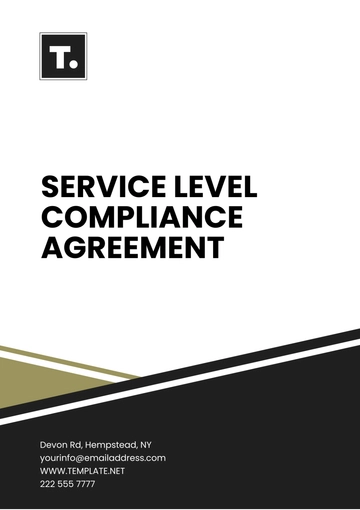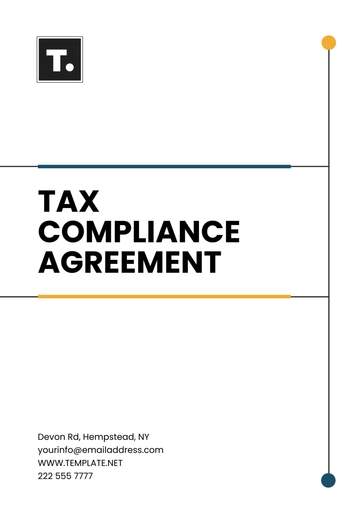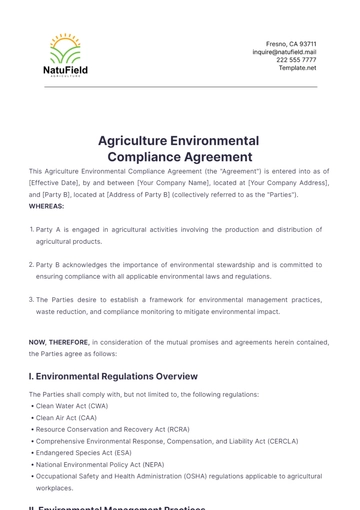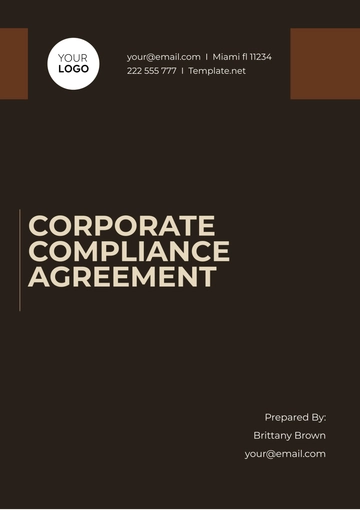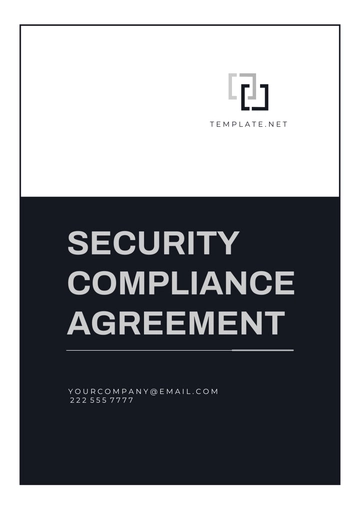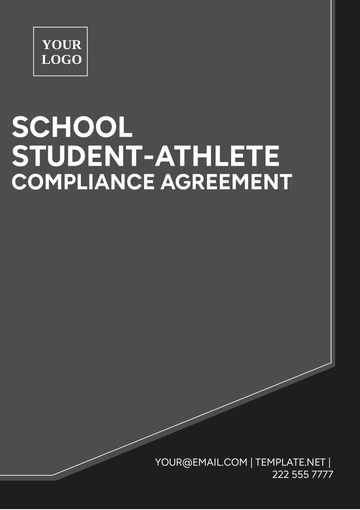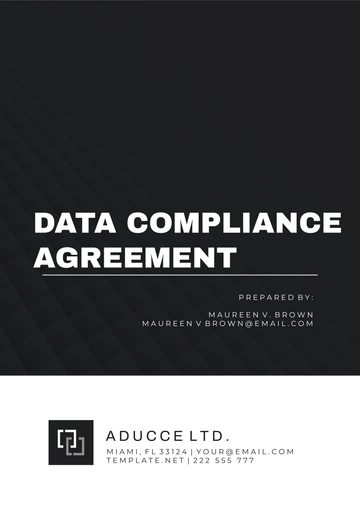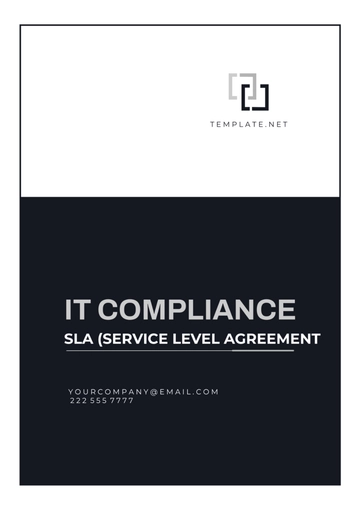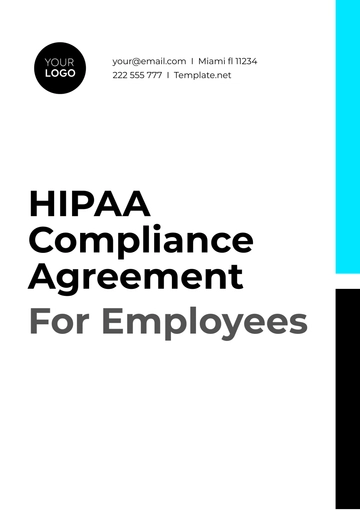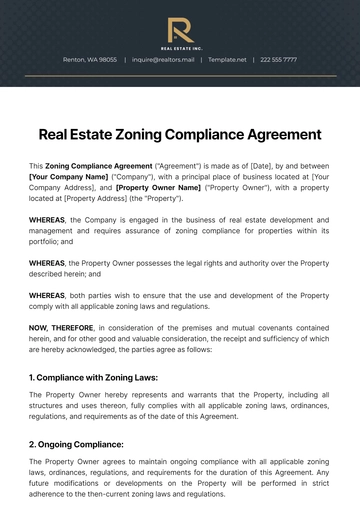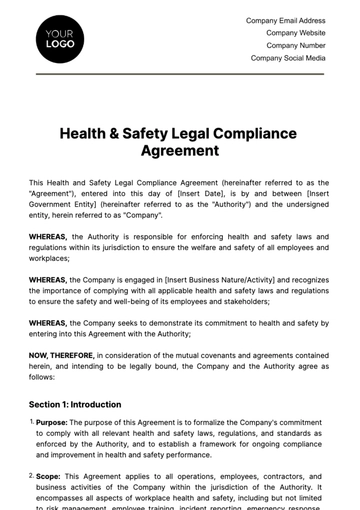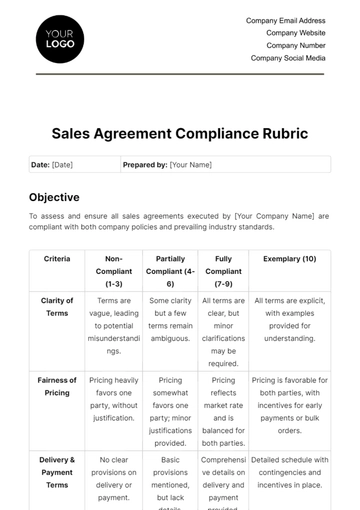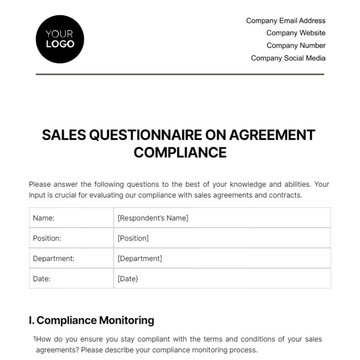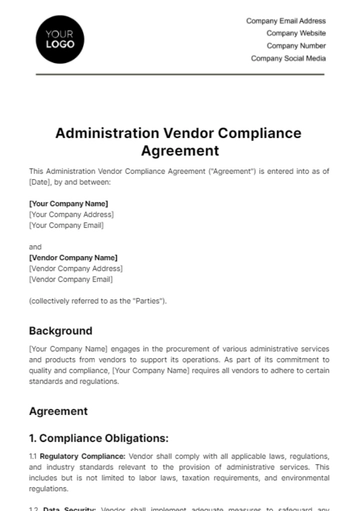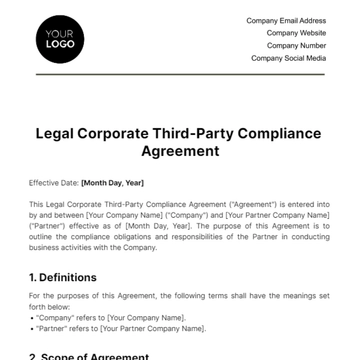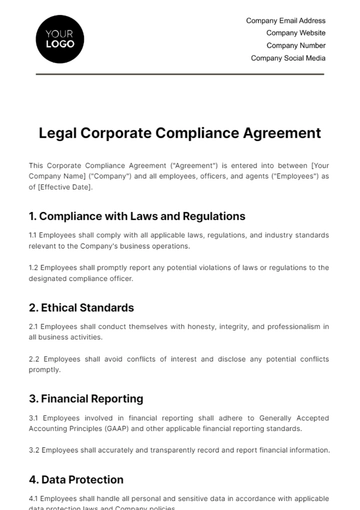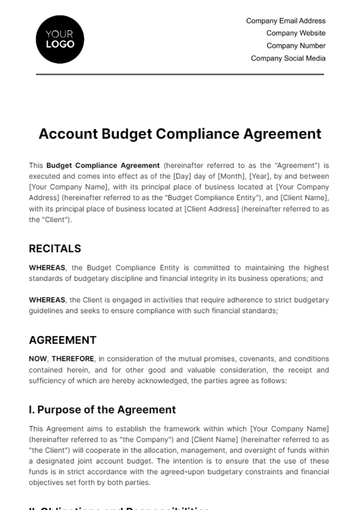Free Security Compliance Agreement
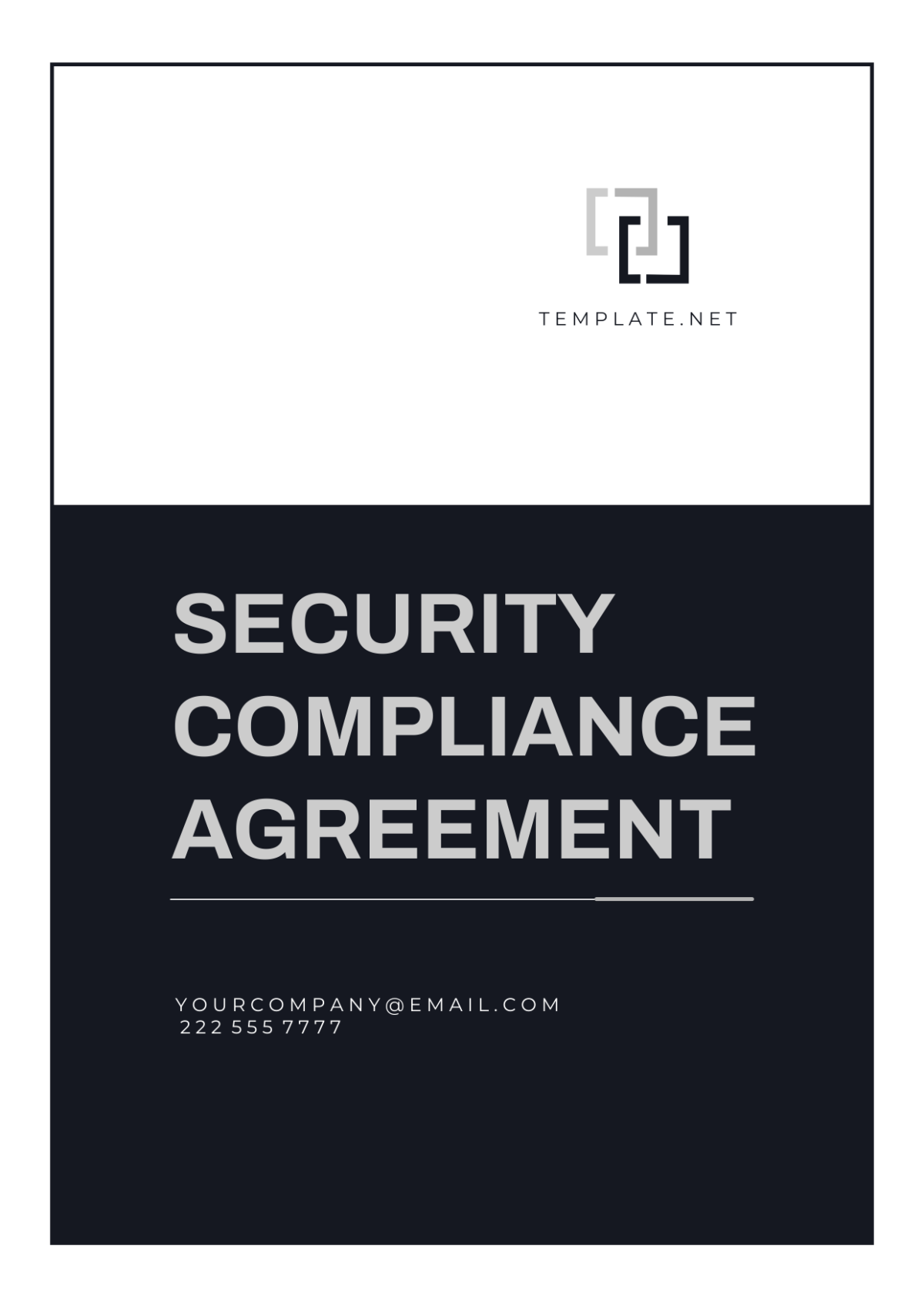
1. Introduction
[Your Company Name] is committed to ensuring the security of its information systems and data. This Security Compliance Agreement Checklist outlines the necessary steps and requirements to maintain compliance with security standards and regulations.
2. Scope
The checklist that has been designed for compliance purposes thoroughly covers a broad range of areas. These areas pertain to all aspects related to the information security of [Your Company Name]. Everything from the policies we have in place to safeguard our information, to the procedures we follow for maintaining this security, and the controls we've established to manage these security measures, are included in the scope of this comprehensive compliance checklist.
3. Responsibilities
3.1 Company Responsibilities:
Implementing security measures outlined in this checklist.
Ensuring compliance with security policies and procedures.
Reporting any security incidents or breaches promptly.
4. Security Policy Review
[Your Company Name]'s security policies should be reviewed annually or whenever there are significant changes to the organization's infrastructure or regulatory environment. Ensure the following policies are in place and up to date:
Information Security Policy
Acceptable Use Policy
Data Classification Policy
Access Control Policy
Incident Response Plan
5. Access Controls
5.1 User Access Management:
Regularly review and update user access permissions based on job roles and responsibilities.
Implement multi-factor authentication for sensitive systems and data access.
5.2 Network Access Controls:
Restrict access to network resources based on business needs.
Implement firewall rules and intrusion detection/prevention systems.
5.3 Data Access Controls:
Encrypt sensitive data both in transit and at rest.
Implement role-based access controls to limit access to sensitive information.
6. Data Protection
6.1 Data Encryption:
Encrypt sensitive data using industry-standard encryption algorithms.
Ensure encryption keys are securely managed and rotated periodically.
6.2 Data Backup:
Regularly backup critical data to secure offsite locations.
Test data restoration procedures to ensure data integrity and availability in case of disaster.
7. Security Awareness Training
Conduct regular security awareness training sessions for all employees, contractors, and third-party vendors.
Ensure training covers topics such as phishing awareness, password security, and incident reporting procedures.
8. Incident Response
Establish an incident response team and define roles and responsibilities.
Develop and regularly test an incident response plan to effectively respond to security incidents and breaches.
Ensure all security incidents are documented, investigated, and reported as per regulatory requirements.
9. Compliance Audits
Conduct periodic internal audits to assess compliance with security policies and procedures.
Engage third-party auditors for independent security assessments and certifications.
Remediate any non-compliance issues identified during audits promptly.
10. Documentation and Record Keeping
Maintain comprehensive documentation of security policies, procedures, and controls.
Retain security-related records for the required retention period as per regulatory requirements.
Ensure documentation is easily accessible and regularly reviewed for accuracy and relevance.
11. Signature
By signing below, you acknowledge that you have reviewed and understand the contents of this compliance checklist.

Compliance Officer
[Your Company Name]
Date: [INSERT DATE]
- 100% Customizable, free editor
- Access 1 Million+ Templates, photo’s & graphics
- Download or share as a template
- Click and replace photos, graphics, text, backgrounds
- Resize, crop, AI write & more
- Access advanced editor
Welcome to Template.net's Security Compliance Agreement Template—a comprehensive solution for your business's legal needs. Our editable and customizable template ensures seamless integration with your company's policies and procedures. Crafted with precision, it guarantees compliance with industry standards. Plus, it's editable in our AI Editor too, facilitating effortless modifications. Elevate your security protocols with ease.
You may also like
- Lease Agreement
- Non Compete Agreement
- Rental Agreement
- Prenuptial Agreement
- Non Disclosure Agreement
- Operating Agreement
- Hold Harmless Agreement
- LLC Operating Agreement
- Arbitration Agreement
- Purchase Agreement
- Residential Lease Agreement
- Executive Agreement
- Confidentiality Agreement
- Contractor Agreement
- Partnership Agreement
- Postnuptial Agreement
- Collective Bargaining Agreement
- Loan Agreement
- Roommate Agreement
- Commercial Lease Agreement
- Separation Agreement
- Cohabitation Agreement
- Room Rental Agreement
- Child Custody Agreement
- Employee Agreement
- License Agreements
- Settlement Agreement
- Joint Venture Agreement
- Indemnity Agreement
- Subordination Agreement
- Sales Agreement
- Agreements Between Two Parties
- Business Agreement
- Real Estate Agreement
- HR Agreement
- Service Agreement
- Property Agreement
- Agreement Letter
- Restaurant Agreement
- Construction Agreement
- Finance Agreement
- Marketing Agreement
- Payment Agreement
- Investment Agreement
- Management Agreement
- Nonprofit Agreement
- Software Agreement
- Startup Agreement
- Agency Agreement
- Copyright Agreement
- Collaboration Agreement
- Reseller Agreement
- Car Rental Agreement
- Cleaning Services Agreement
- Consultant Agreement
- Deed Agreement
- Car Agreement
- Equipment Agreement
- Shares Agreement
- Data Sharing Agreement
- Advertising Agreement
- School Agreement
- Franchise Agreement
- Event Agreement
- Travel Agency Agreement
- Vehicle Agreement
- Board Resolution Agreement
- Land Agreement
- Binding Agreement
- Tenancy Agreement
- Exclusive Agreement
- Development Agreement
- Assignment Agreement
- Design Agreement
- Equity Agreement
- Mortgage Agreement
- Purchase and Sale Agreement
- Shareholder Agreement
- Vendor Agreement
- Royalty Agreement
- Vehicle Lease Agreement
- Hotel Agreement
- Tenant Agreement
- Artist Agreement
- Commission Agreement
- Consignment Agreement
- Debt Agreement
- Recruitment Agreement
- Training Agreement
- Transfer Agreement
- Apprenticeship Agreement
- IT and Software Agreement
- Referral Agreement
- Resolution Agreement
- Waiver Agreement
- Consent Agreement
- Partner Agreement
- Social Media Agreement
- Customer Agreement
- Credit Agreement
- Supply Agreement
- Agent Agreement
- Brand Agreement
- Law Firm Agreement
- Maintenance Agreement
- Mutual Agreement
- Retail Agreement
- Deposit Agreement
- Land Purchase Agreement
- Nursing Home Agreement
- Supplier Agreement
- Buy Sell Agreement
- Child Support Agreement
- Landlord Agreement
- Payment Plan Agreement
- Release Agreement
- Research Agreement
- Sponsorship Agreement
- Buyout Agreement
- Equipment Rental Agreement
- Farm Agreement
- Manufacturing Agreement
- Strategic Agreement
- Termination of Lease Agreement
- Compliance Agreement
- Family Agreement
- Interior Design Agreement
- Ownership Agreement
- Residential Lease Agreement
- Retainer Agreement
- Trade Agreement
- University Agreement
- Broker Agreement
- Dissolution Agreement
- Funding Agreement
- Hosting Agreement
- Investor Agreement
- Memorandum of Agreement
- Advisory Agreement
- Affiliate Agreement
- Freelancer Agreement
- Grant Agreement
- Master Service Agreement
- Parking Agreement
- Subscription Agreement
- Trust Agreement
- Cancellation Agreement
- Horse Agreement
- Influencer Agreement
- Membership Agreement
- Vacation Rental Agreement
- Wholesale Agreement
- Author Agreement
- Distributor Agreement
- Exchange Agreement
- Food Agreement
- Guarantee Agreement
- Installment Agreement
- Internship Agreement
- Music Agreement
- Severance Agreement
- Software Development Agreement
- Storage Agreement
- Facility Agreement
- Intercompany Agreement
- Lending Agreement
- Lodger Agreement
- Outsourcing Services Agreement
- Usage Agreement
- Assurance Agreement
- Photography Agreement
- Profit Sharing Agreement
- Relationship Agreement
- Rent To Own Agreement
- Repayment Agreement
- Volunteer Agreement
- Co Parenting Agreement
- HVAC Agreement
- Lawn Care Agreement
- SAAS Agreement
- Work from Home Agreement
- Coaching Agreement
- Protection Agreement
- Security Agreement
- Repair Agreement
- Agreements License
